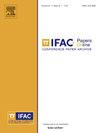Control structures for heat delivery in compact bottoming cycles for heat and power production⁎
Q3 Engineering
引用次数: 0
Abstract
Compact designs of combined cycle power plants based on gas turbines and steam bottoming cycle (CCGTs) are deemed as a promising technology for increasing energy efficiency and reducing greenhouse gas emissions of offshore oil and gas production facilities. The control of such systems can be challenging due to the need for operational flexibility regarding production of power and heat to satisfy the corresponding demands, and it differs from traditional onshore designs in dynamic characteristics and requirements. In this work, we propose and evaluate the performance of control structures for compact steam bottoming cycles with combined heat and power production, focusing on the solutions for satisfying heat demands and their effect on power production. The proposed control structures are based on the different prioritization of operational objectives and constraints, using simple control elements to switch between operating regions. The control structures were evaluated under different disturbances on the gas turbine loads and on the heat demand. It is shown that controlling the intermediate pressure in the steam turbine, which serves as source of steam for heat production, is necessary for achieving the heat demand objectives. We also show that sudden disturbances on the heat demand heavily impact the power production, and it is desirable that such disturbances happen on a ramp-like manner. Overall, we highlight how near-optimal operation with satisfaction of constraints can be achieved with the use of well-designed, simple control structures.
用于热和电力生产的紧凑型底部循环的热传递控制结构
基于燃气轮机和蒸汽底循环(ccgt)的紧凑型联合循环电厂设计被认为是提高海上油气生产设施能源效率和减少温室气体排放的一种有前途的技术。这种系统的控制具有挑战性,因为它需要在发电和供热方面具有灵活性,以满足相应的需求,而且它与传统的陆上设计在动态特性和要求上有所不同。在这项工作中,我们提出并评估了热电联产紧凑型蒸汽底循环控制结构的性能,重点是满足热需求的解决方案及其对发电的影响。所提出的控制结构基于不同的操作目标和约束的优先级,使用简单的控制元素在操作区域之间切换。在不同的燃气轮机负荷和热需求扰动下,对控制结构进行了评价。研究表明,控制汽轮机中间压力是实现汽轮机热需求目标的必要条件,汽轮机是汽轮机产热的蒸汽源。我们还表明,热需求上的突然干扰严重影响了电力生产,并且希望这种干扰以坡道方式发生。总的来说,我们强调了如何通过使用设计良好的、简单的控制结构来实现满足约束的接近最优操作。
本文章由计算机程序翻译,如有差异,请以英文原文为准。
求助全文
约1分钟内获得全文
求助全文
来源期刊

IFAC-PapersOnLine
Engineering-Control and Systems Engineering
CiteScore
1.70
自引率
0.00%
发文量
1122
期刊介绍:
All papers from IFAC meetings are published, in partnership with Elsevier, the IFAC Publisher, in theIFAC-PapersOnLine proceedings series hosted at the ScienceDirect web service. This series includes papers previously published in the IFAC website.The main features of the IFAC-PapersOnLine series are: -Online archive including papers from IFAC Symposia, Congresses, Conferences, and most Workshops. -All papers accepted at the meeting are published in PDF format - searchable and citable. -All papers published on the web site can be cited using the IFAC PapersOnLine ISSN and the individual paper DOI (Digital Object Identifier). The site is Open Access in nature - no charge is made to individuals for reading or downloading. Copyright of all papers belongs to IFAC and must be referenced if derivative journal papers are produced from the conference papers. All papers published in IFAC-PapersOnLine have undergone a peer review selection process according to the IFAC rules.
 求助内容:
求助内容: 应助结果提醒方式:
应助结果提醒方式:


